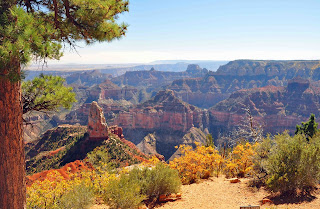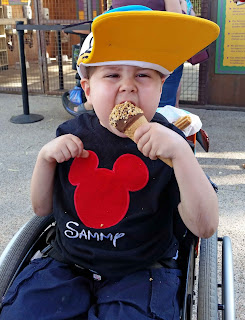 |
| Monument Valley from the North |
 |
| Pit House Diagram, Anasazi Cultural Center |
The
ruins and artifacts in this area span several periods of history for these
people. The earliest peoples were wanderer-hunters. There are some artifact tools and arrowheads
found from these earliest wandering peoples.
The introduction of corn (maze), probably from Mexico, changed their
living style to those of farmers staying in one place. The earliest farmer period was called the
Basketmaker Period, where the people made baskets and other items from the
fiber of the yucca plant and lived in teepee like homes, which soon advanced to
become Pit Houses; dug out areas framed on top with wood and covered in mud
(adobe). The entrance was through a hole
in the top and a ladder; the hole was also the smoke hole. We saw examples of the ruins of these Pit Homes
scattered throughout the ruins in the area.
The Puebloan Peoples lived in the same areas for centuries, often
building on prior pueblo ruins.
 |
| Row of Doorways, Pueblo I, Aztec NM, New Mexico |
From
about 750-950 AD, during the Pueblo I period the people started to build more
complex single story pueblos from adobe bricks.
The villages were usually near a water source at the head of the
canyons, with the fields and villages on the mesa tops. The beginning of more complex societies, with
rituals and community rooms (round kivas), were of note. The best example of this period is found at
Chaco Canyon National Historic Site.
 |
| Pueblo II, Multi-story Pueblo, Aztec NM |
The
Pueblo II period extended from 950 – 1150.
The pueblos became more complex, multi-story (up to 3 stories in many
places), but the pueblos were still on the mesa tops. We saw an excellent example of these ruins at
Hovenweep National Monument, Lowry Pueblo in the Canyons of the Ancients
National Monument, and at Aztec National Monument.
 |
| Cliff Dwellings, Mesa Verde NM |
The
biggest change occurred in Pueblo III period, about 1150-1300. Here the people moved their pueblos from the
mesa top to under large overhangs on the cliff faces. The locations were often selected right at
the water source. The best examples of
these were seen at Mesa Verde, but these types of ruins are found throughout
the area. There are over 6000 ruin sites
in the Canyon of the Ancients alone. At
the height of their culture, over 5000 people lived in a small 25 square mile
area!
 |
| Long House Pueblo, Mesa Verde NM |
We
took two fabulous ranger-guided tours in Mesa Verde. The Long House Tour was a fabulous detailed
2.5 hour tour of the largest known cliff dwelling ruin (Cliff Palace, which was
already closed for the season, is the same size). We got a real sense of the lifestyle of the
occupants, much of which is speculated based on the current customs and
lifestyles of current Puebloan peoples (such as the Zuni and Hopi).
 |
| Linda climbing Ladder |
The
Balcony House Tour was the most strenuous tour offered. We climbed down a large number of stairs to a
path below the cliff, and then climbed an almost vertical 32-foot tree ladder
to get into the site. It is a small
pueblo, with only 2 kivas, and perhaps 40 rooms. The reason it is called Balcony House is that
some of the rooms have a balcony on the outside wall. The ranger did a great job integrating the
lives of the residents and the connection to current Pueblo peoples. We had to walk through a very tight cleft in
the canyon to move from one side to the other of the village. The exit from the pueblo was the most
interesting: we had to crawl through an
18-inch wide 12-ft long tunnel. Some of
the larger men (but not Bob) had to crawl through at an angle. Linda went first pushing our backpack in
front on her; Bob followed. The tunnel
appeared to be defensive in nature; there was a hole in the roof where someone
in the pueblo could look down and see who was there (and kill them if needed?).
The
Puebloan Peoples dispersed about 1300AD.
It is not clear what the reasons were, but it is believed to be a
combination of a 30 year drought, scarcity of resources, over population, and
perhaps inter-tribal strife.
 |
| Clay Pot Artifacts from McFee Dam Excavation |
One
of the best museums we visited was the Anasazi Cultural Center. A huge archeological excavation was done
prior to the construction of the McFee Dam and Reservoir, and over 1 million
artifacts were collected – most in excellent shape - and put into the Cultural
Center. It is worth a visit.
 |
| Artifact Spearpoints and Knife Blades |
Political
correctness has even reached this area of history. After being call the Anasazi for centuries,
the name is being changed to the “Ancient Puebloan Peoples”; Anasazi is not a
Puebloan Peoples word, rather a Navajo word for them. Interestedly, prior to
the reservoir construction the local Puebloans opposed the project for fear of
losing their ancestry and artifacts, but the formation of the Anasazi Cultural
Center and extensive archeological research satisfied their concerns. The NPS is evaluating changing the name from
Anasazi to the Ancient Puebloan Cultural Center.
 |
| Valley of the Gods |
 |
| Monument Valley |
 |
| Vermillion Cliffs |
We
left the Four Corners area and took a circuitous route to enjoy for a second
time some of the most beautiful scenery in the West; on our way to the North Rim of the Grand
Canyon, we journeyed through the Valley of the Gods, Monument Valley, Lake
Powell, and Vermillion Cliffs. We arrived at the North Rim the last week before
it was closed for the winter.
 |
| Fall, North Rim Grand Canyon |
The
North Rim of the Grand Canyon is a very different experience than the South Rim.
It is much more remote, with a lot fewer people (only 10% of the tourists as
the South Rim – that was great), fewer services which include a small, rustic lodge
and our primitive campground. The hikes
are great, through pinon pine forests, but Linda thinks the views to the south
are not as spectacular as from the south rim. Bob really likes the north rim
view as well - the hikes actually take
you through Kanab Limestone outcrops – unlike the south rim. One big reason is that side-canyon erosion
mostly occurs on the north rim, so rather than a long rim running parallel to and just south of the Colorado
River, the north rim is a series of in-your-face long mesas and deep canyons. In addition to sitting around our campground
fire, we had a great time one evening drinking wine and watching the sun set
from the lodge patio.
 |
| Sunset from Lodge Patio, North Rim Grand Canyon |
 |
| Fall, North Rim Grand Canyon |
 |
| Sedona Red Rocks |
It
was chilly in the evening at the rim (it was getting below freezing late at
night), so we left a day early and decided to spend a night to enjoy the views
and dinner in Sedona. We utilized the RV
parking at the really nice Sedona Elks Lodge with great views. The red rock canyons did not disappoint. Even though we were there only for one night
and the next morning, the views remain as spectacular as always. We had a great dinner at an Italian
Restaurant just west of town, and ate on the patio listening to “Sammy Davis
Jr” - a wonderful warm evening after the cold of the past two weeks.
 |
| Bob, Logan, Linda Charles, Kristen and Sammy |
Our
last stop south was in the HOT desert of Phoenix (98 the first day we were
there). We visited Kristen and Charles Puma, Linda’s niece, and their two boys,
Sammy (6 yrs) and Logan (almost 3).
Sammy has terminal brain cancer, and we wanted to spend some quality
time with the family. We had a great
visit which included a Mexican dinner out, time at their church, and a
wonderful afternoon at the Phoenix Zoo.
The zoo has a new exhibit, Dinosaurs in the Desert, a take-off on
Jurassic Park. The boys were a little
intimidated by the Huge dinosaurs, which were all moving and well done (Disney
would be proud). We enjoyed our family
time, and will forever cherish our memories of Sammy.
 |
| Sammy enjoying his 2nd Ice Cream of Day |
PLEASE PRAY FOR SAMMY AND HIS FAMILY, they
need all the prayers they can get.
We
are now headed to the final destination on our 3-year journey,
Albuquerque. We will attend Balloon Fest
and visit other points of interest in the area, and then head back to Florida,
stopping on the way to visit friends in Texas and family in Alabama.
We
continue to thank God for his blessings and remain thankful for our health to be
able to continue our travels and exploration of this wonderful country.
Feel free to pass the blog link on
to anyone who might be interested.
Best to all,
Linda and Bob

No comments:
Post a Comment